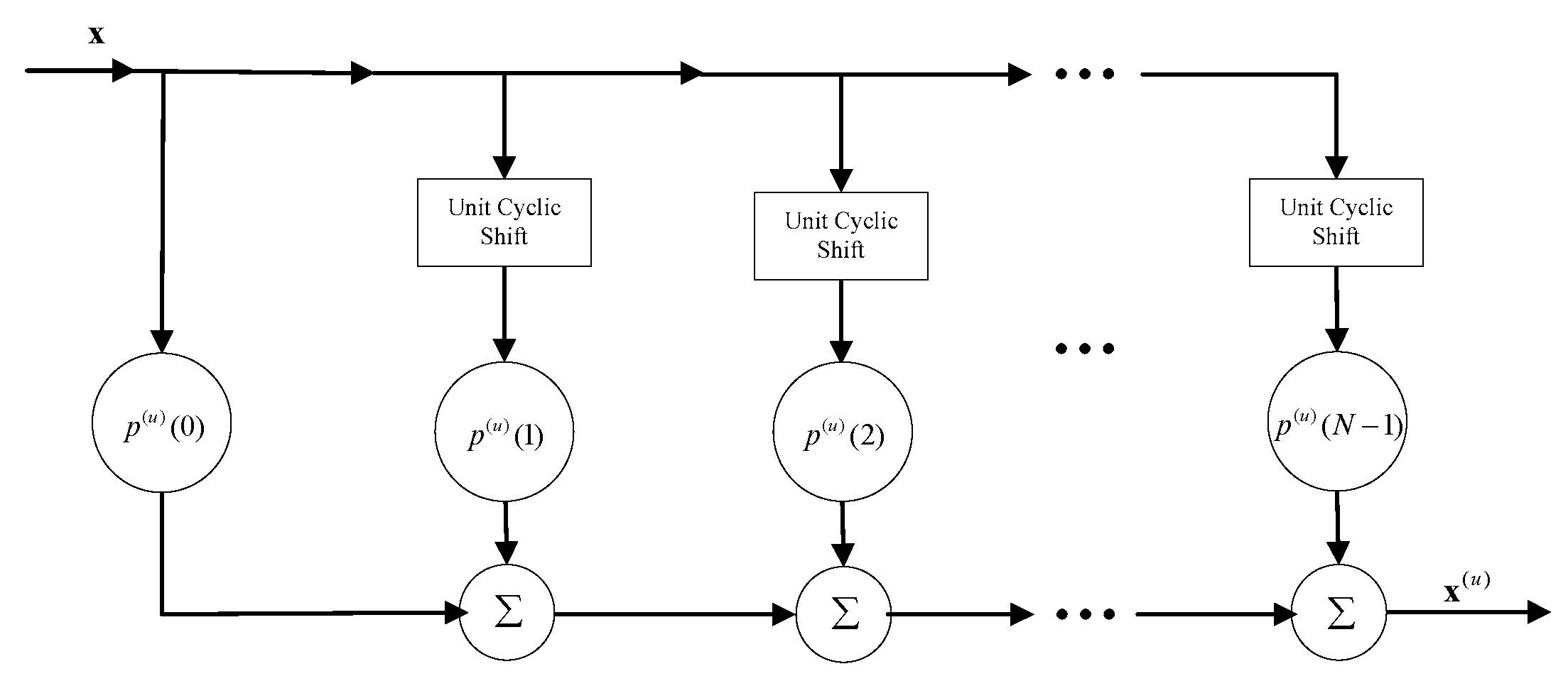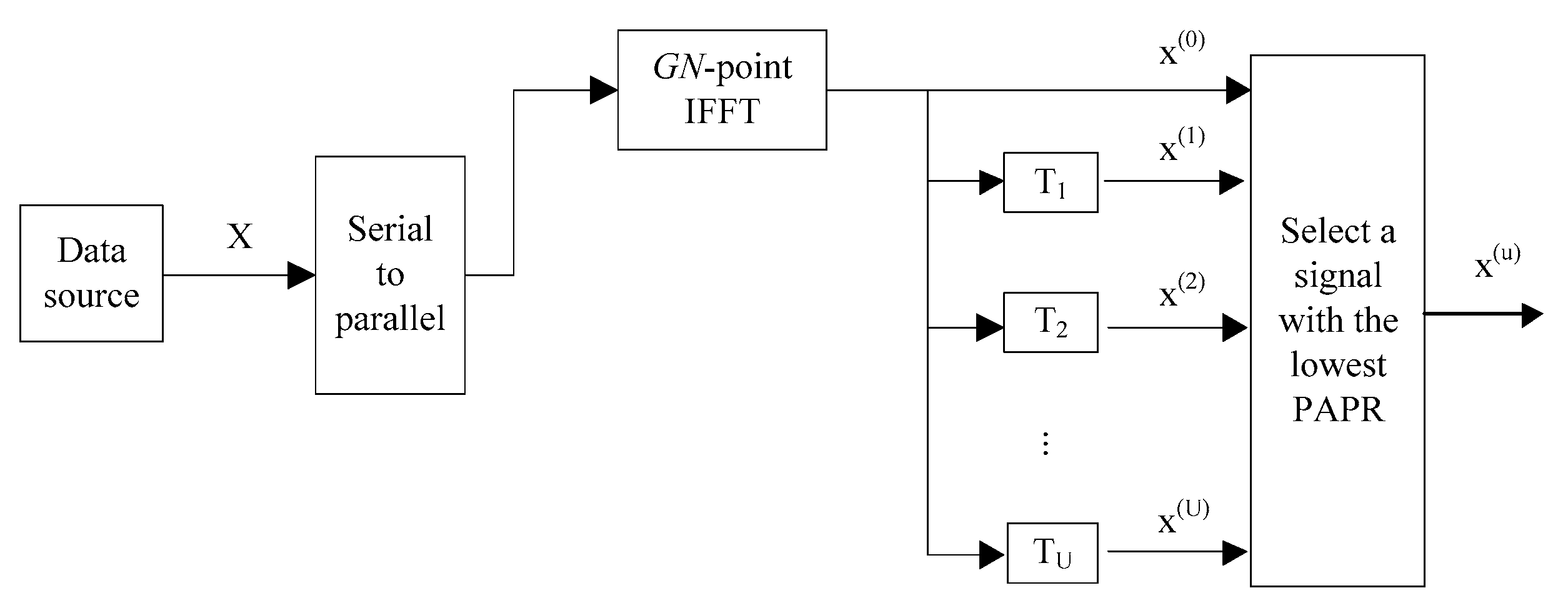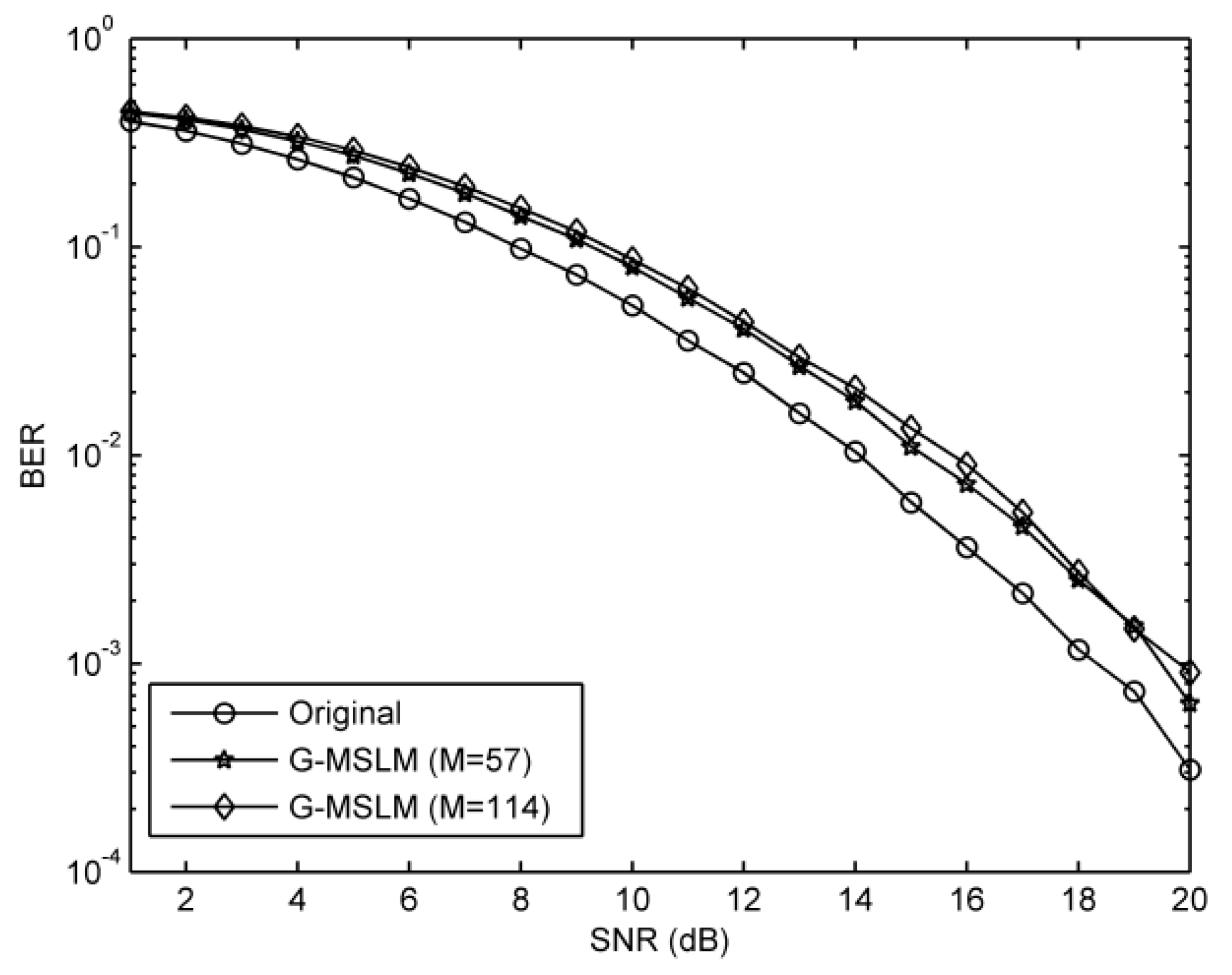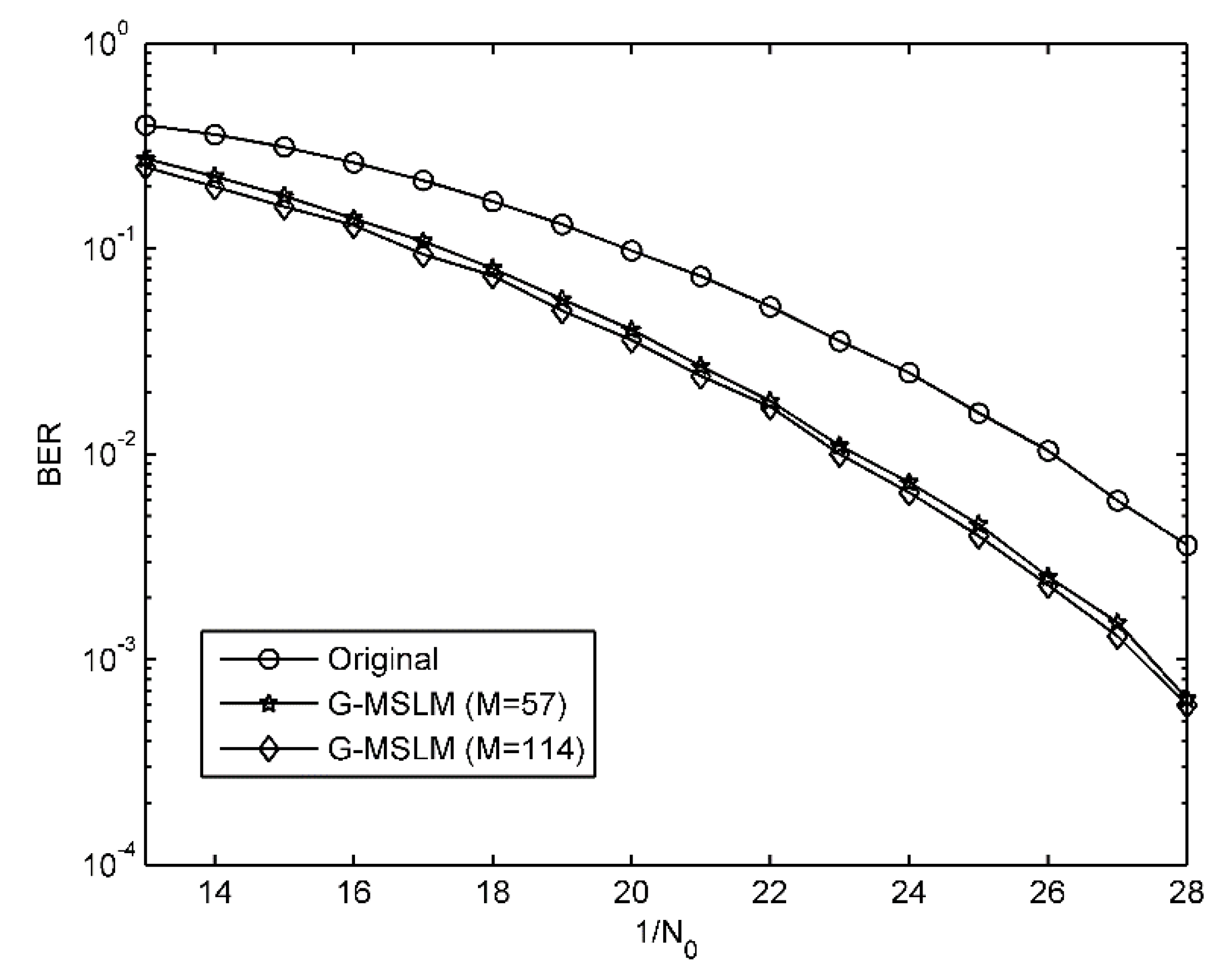Low-Complexity Blind Selected Mapping Scheme for Peak-to-Average Power Ratio Reduction in Orthogonal Frequency-Division Multiplexing Systems
Abstract
:1. Introduction
2. System Models
3. Proposed SLM PAPR Scheme
3.1. Derived General Form of SLM in the Time Domain
3.2. Proposed Low-Complexity Conversion Vectors
- (1)
- The support Lu of is chosen as a small integer to restrict the length of the equivalent channel;
- (2)
- There are few nonzero elements whose number is denoted as K in to reduce the complexity in generating the candidate signals with Equation (11);
- (3)
- The real and imaginary parts of each nonzero element in are chosen in the set to avoid the complex multiplications in generating the candidate signals (ignoring the constant factor to maintain the power constraint) [10].
3.3. Complexity Analysis
4. Simulation Results
5. Conclusions
Author Contributions
Acknowledgments
Conflicts of Interest
References
- Jiang, T.; Wu, Y. An overview: peak-to-average power ratio reduction techniques for OFDM signals. IEEE Trans. Broadcast. 2008, 54, 257–268. [Google Scholar] [CrossRef]
- Hasan, M. A novel CVM precoding scheme for PAPR reduction in OFDM transmissions. Wirel. Netw. 2014, 20, 1573–1581. [Google Scholar] [CrossRef]
- Adegbite, S.A.; McMeekin, S.G.; Stewart, B.G. A joint OFDM PAPR reduction and data decoding scheme with no SI estimation. EURASIP J. Wirel. Commun. Netw. 2016, 108, 1–12. [Google Scholar] [CrossRef]
- Sohn, I.; Chul, S. Neural network based simplified clipping and filtering technique for PAPR reduction of OFDM signals. IEEE Commun. Lett. 2015, 19, 1438–1441. [Google Scholar] [CrossRef]
- Mazahir, S.; Amin, S. On companding schemes for PAPR reduction in OFDM systems employing higher order QAM. IEEE Trans. Broadcast. 2016, 62, 716–726. [Google Scholar] [CrossRef]
- Heo, S.; Noh, H.; No, J.; Shin, D. A modified SLM scheme with low complexity for PAPR reduction of OFDM systems. IEEE Trans. Broadcast. 2007, 53, 804–808. [Google Scholar] [CrossRef]
- Wang, C.; Hsu, M.; Ouyang, Y. A low-complexity peak-to-average power ratio reduction technique for OFDM systems. In Proceedings of the 2003 Global Telecommunications Conference, San Francisco, CA, USA, 1–5 December 2003. [Google Scholar]
- Wang, C.; Hsu, M.; Ouyang, Y. Low-complexity selected mapping schemes for peak-to-average power ratio reduction in OFDM systems. IEEE Trans. Signal Process. 2005, 53, 4652–4660. [Google Scholar] [CrossRef]
- Wang, C.; Ku, S. Novel conversion matrices for simplifying the IFFT computation of an SLM-based PAPR reduction scheme for OFDM systems. IEEE Trans. Wirel. Commun. 2009, 57, 1903–1907. [Google Scholar] [CrossRef]
- Li, C.; Wang, S.; Wang, C. Novel low-complexity SLM schemes for PAPR reduction in OFDM systems. IEEE Trans. Signal Process. 2010, 58, 2916–2921. [Google Scholar] [CrossRef]
- Jayalath, A.; Tellambura, C. SLM and PTS peak-power reduction of OFDM signals without side information. IEEE Trans. Wirel. Commun. 2005, 4, 2006–2013. [Google Scholar] [CrossRef] [Green Version]
- Joo, H.; Heo, S.; Jeon, H.; No, J.; Shin, D. A new blind SLM scheme with low decoding complexity for OFDM systems. IEEE Trans. Broadcast. 2012, 58, 669–676. [Google Scholar] [CrossRef]
- Goff, S.; Al-Samahi, S.; Khoo, B.; Tsimenidis, C.; Sharif, B. Selected mapping without side information for PAPR reduction in OFDM. IEEE Trans. Wirel. Commun. 2009, 8, 3320–3325. [Google Scholar] [CrossRef]
- Park, J.; Hong, E.; Har, D. Low complexity data decoding for SLM based OFDM systems without side information. IEEE Commun. Lett. 2011, 15, 611–613. [Google Scholar] [CrossRef]
- Tellambura, C. Computation of the continuous-time PAR of an OFDM signal with BPSK subcarriers. IEEE Commun. Lett. 2001, 5, 185–187. [Google Scholar] [CrossRef]
- Gerhard, W.; Robert, F.; Holge, B. The PAPR problem in OFDM transmission: new directions for a long-lasting problem. IEEE Signal Process. Mag. 2013, 30, 130–144. [Google Scholar] [CrossRef]
- Baek, M.; Kim, M.; You, Y.; Song, H. Semi-blind channel estimation and par reduction for MIMO-OFDM system with multiple antennas. IEEE Trans. Broadcast. 2004, 50, 414–424. [Google Scholar] [CrossRef]
- Yuen, C.; Behrouz, F. Analysis of the optimum precoder in SC-FDMA. IEEE Trans. Wirel. Commun. 2012, 11, 4096–4107. [Google Scholar] [CrossRef]
- Tsiropoulou, E.E.; Kapoukakis, A.; Papavassiliou, S. Uplink resource allocation in SC-FDMA wireless networks: A survey and taxonomy. Comput. Netw. 2016, 96, 1–28. [Google Scholar] [CrossRef]
- Malka, D.; Zalevsky, Z.; Sintov, Y. Design of a 1 × 4 silicon wavelength demultiplexer based on multimode interference in a slot waveguide structures. J. Opt. 2015, 17, 1–9. [Google Scholar] [CrossRef]
- Ben Zaken, B.B.; Zanzury, T.; Malka, D. An 8-channel wavelength mmi demultiplexer in slot waveguide structures. Materials 2016, 9, 881. [Google Scholar] [CrossRef] [PubMed]






| Number of Nonzero Elements | Indices of Nonzero Elements | Values of Nonzero Elements |
|---|---|---|
| , , and | , and , | |
| and | , |
| PAPR Schemes | Number of CMs | Number of CAs |
|---|---|---|
| Conventional SLM method | (UGN/2)log2(GN) | UGNlog2(GN) |
| SLM method in [10] | (GN/2)log2(GN) | GNlog2(GN) + (U − 1)(K − 1)GN |
| Proposed method | (GN/2)log2(GN) | GNlog2(GN) + (U − 1)(K − 1)GN |
© 2018 by the authors. Licensee MDPI, Basel, Switzerland. This article is an open access article distributed under the terms and conditions of the Creative Commons Attribution (CC BY) license (http://creativecommons.org/licenses/by/4.0/).
Share and Cite
Xia, Y.; Ji, J. Low-Complexity Blind Selected Mapping Scheme for Peak-to-Average Power Ratio Reduction in Orthogonal Frequency-Division Multiplexing Systems. Information 2018, 9, 220. https://doi.org/10.3390/info9090220
Xia Y, Ji J. Low-Complexity Blind Selected Mapping Scheme for Peak-to-Average Power Ratio Reduction in Orthogonal Frequency-Division Multiplexing Systems. Information. 2018; 9(9):220. https://doi.org/10.3390/info9090220
Chicago/Turabian StyleXia, Yujie, and Jinwei Ji. 2018. "Low-Complexity Blind Selected Mapping Scheme for Peak-to-Average Power Ratio Reduction in Orthogonal Frequency-Division Multiplexing Systems" Information 9, no. 9: 220. https://doi.org/10.3390/info9090220




